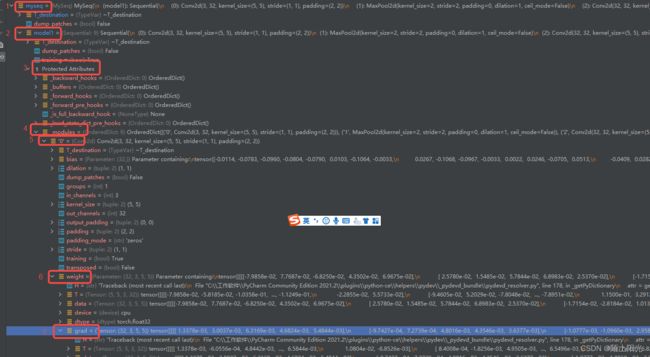学习pytorch14 损失函数与反向传播
神经网络-损失函数与反向传播
- 官网
- 损失函数
-
- L1Loss MAE 平均
- MSELoss 平方差
- CROSSENTROPYLOSS 交叉熵损失
-
- 注意
- code
- 反向传播
-
- 在debug中的显示
-
- code
B站小土堆pytorch视频学习
官网
https://pytorch.org/docs/stable/nn.html#loss-functions

损失函数
L1Loss MAE 平均
import torch
input = torch.tensor([1, 2, 3], dtype=float)
# target = torch.tensor([1, 2, 5], dtype=float)
target = torch.tensor([[[[1, 2, 5]]]], dtype=float) # shape [1, 1, 1, 3]
input = torch.reshape(input, (1,1,1,3))
# target = torch.reshape(target, (1,1,1,3))
print(input.shape)
print(target.shape)
loss1 = torch.nn.L1Loss()
loss2 = torch.nn.L1Loss(reduction="sum")
result1 = loss1(input, target)
print(result1) # tensor(0.6667, dtype=torch.float64)
result2 = loss2(input, target)
print(result2) # tensor(2., dtype=torch.float64)
MSELoss 平方差
import torch
input = torch.tensor([1, 2, 3], dtype=float)
# target = torch.tensor([1, 2, 5], dtype=float)
target = torch.tensor([[[[1, 2, 5]]]], dtype=float) # shape [1, 1, 1, 3]
input = torch.reshape(input, (1,1,1,3))
# target = torch.reshape(target, (1,1,1,3))
print(input.shape)
print(target.shape)
loss_mse = torch.nn.MSELoss(reduction='mean')
result_mse = loss_mse(input, target)
print(result_mse) # tensor(1.3333, dtype=torch.float64)
loss_mse2 = torch.nn.MSELoss(reduction='sum')
result_mse2 = loss_mse2(input, target)
print(result_mse2) # tensor(4., dtype=torch.float64)
CROSSENTROPYLOSS 交叉熵损失
https://pytorch.org/docs/stable/generated/torch.nn.CrossEntropyLoss.html#torch.nn.CrossEntropyLoss


在神经网络中,默认log是以e为底的,所以也可以写成ln


注意
- 根据需求选择对应的loss函数
- 注意loss函数的输入输出shape
code
import torch
import torchvision
from torch import nn
from torch.nn import Conv2d, MaxPool2d, Flatten, Linear, Sequential
from torch.utils.data import DataLoader
from torch.utils.tensorboard import SummaryWriter
test_set = torchvision.datasets.CIFAR10("./dataset", train=False, transform=torchvision.transforms.ToTensor(),
download=True)
dataloader = DataLoader(test_set, batch_size=1)
class MySeq(nn.Module):
def __init__(self):
super(MySeq, self).__init__()
self.model1 = Sequential(Conv2d(3, 32, kernel_size=5, stride=1, padding=2),
MaxPool2d(2),
Conv2d(32, 32, kernel_size=5, stride=1, padding=2),
MaxPool2d(2),
Conv2d(32, 64, kernel_size=5, stride=1, padding=2),
MaxPool2d(2),
Flatten(),
Linear(1024, 64),
Linear(64, 10)
)
def forward(self, x):
x = self.model1(x)
return x
loss = nn.CrossEntropyLoss()
myseq = MySeq()
print(myseq)
for data in dataloader:
imgs, targets = data
print(imgs.shape)
output = myseq(imgs)
result = loss(output, targets)
print(result)
反向传播
在debug中的显示
显示在网络结构中,每一层的保护属性中,都有weight属性,梯度属性在weitht属性里面
先找模型结构 在找每一层 在找weight权重,梯度在weight权重里面
code
核心代码:result_loss.backward() # 要在最后获取 backward函数要挂在通过loss函数计算后的结果上。
# 模型定义、数据加载 同上个代码
for data in dataloader:
imgs, targets = data
print(imgs.shape)
output = myseq(imgs)
result_loss= loss(output, targets)
result_loss.backward() # 要在最后获取
print(result_loss)
print(result_loss.grad)





